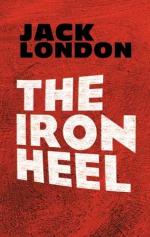As for the militia, the militia law of 1903 was put into effect, and the workers of one state were compelled, under pain of death, to shoot down their comrade-workers in other states. Of course, the militia law did not work smoothly at first. Many militia officers were murdered, and many militiamen were executed by drumhead court martial. Ernest’s prophecy was strikingly fulfilled in the cases of Mr. Kowalt and Mr. Asmunsen. Both were eligible for the militia, and both were drafted to serve in the punitive expedition that was despatched from California against the farmers of Missouri. Mr. Kowalt and Mr. Asmunsen refused to serve. They were given short shrift. Drumhead court martial was their portion, and military execution their end. They were shot with their backs to the firing squad.
Many young men fled into the mountains to escape serving in the militia. There they became outlaws, and it was not until more peaceful times that they received their punishment. It was drastic. The government issued a proclamation for all law-abiding citizens to come in from the mountains for a period of three months. When the proclaimed date arrived, half a million soldiers were sent into the mountainous districts everywhere. There was no investigation, no trial. Wherever a man was encountered, he was shot down on the spot. The troops operated on the basis that no man not an outlaw remained in the mountains. Some bands, in strong positions, fought gallantly, but in the end every deserter from the militia met death.
A more immediate lesson, however, was impressed on the minds of the people by the punishment meted out to the Kansas militia. The great Kansas Mutiny occurred at the very beginning of military operations against the Grangers. Six thousand of the militia mutinied. They had been for several weeks very turbulent and sullen, and for that reason had been kept in camp. Their open mutiny, however, was without doubt precipitated by the agents-provocateurs.
On the night of the 22d of April they arose and murdered their officers, only a small remnant of the latter escaping. This was beyond the scheme of the Iron Heel, for the agents-provocateurs had done their work too well. But everything was grist to the Iron Heel. It had prepared for the outbreak, and the killing of so many officers gave it justification for what followed. As by magic, forty thousand soldiers of the regular army surrounded the malcontents. It was a trap. The wretched militiamen found that their machine-guns had been tampered with, and that the cartridges from the captured magazines did not fit their rifles. They hoisted the white flag of surrender, but it was ignored. There were no survivors. The entire six thousand were annihilated. Common shell and shrapnel were thrown in upon them from a distance, and, when, in their desperation, they charged the encircling lines, they were mowed down by the machine-guns. I talked with an eye-witness, and he said that the nearest any militiaman approached the machine-guns was a hundred and fifty yards. The earth was carpeted with the slain, and a final charge of cavalry, with trampling of horses’ hoofs, revolvers, and sabres, crushed the wounded into the ground.




